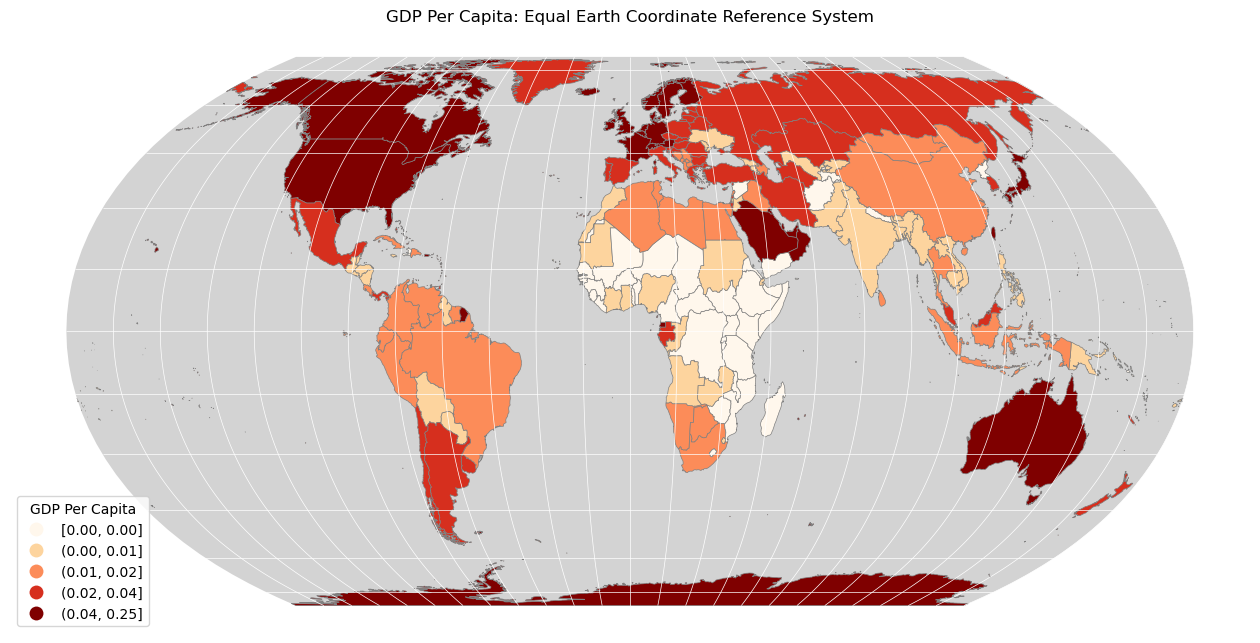1. Understanding GIS
A quick note about the practicals...
Remember that coding should be done in Spyder using the understandinggis virtual environment. If you want to install the environment on your own computer, you can do so using the instructions here.
You do not have to run every bit of code in this document. Read through it, and have a go where you feel it would help your understanding. If I explicitly want you to do something, I will write an instruction that looks like this:
This is an instruction.
Shortcuts: Part 1 Part 2
In which we are introduced to Python and Spyder, and make our first programmatic map with Python.
Part 1.
Note: If you are working on your own machine, you will need to install the understandinggis Python environment before completing this practical. The instructions for this can be found here.
What is Python?

Python is a programming language that is named after the classic British comedy troupe Monty Python. It is what we would describe as a high level programming language, which means that it is typically less complicated and a bit more user friendly than more low level languages such as C, C++ or Java. The general rule is that high level languages make it quicker and easier to write code, but at the expense of those programs being slightly slower when they execute.
The exciting thing about Python is that it can link up with lower-level languages such as C or C++ through the use of libraries, which means that you can get the best of both worlds: code that is simple and efficient to write, but which runs quickly too! We will be using several such libraries throughout this course, which will handle complex and otherwise mundane tasks for us such as reading and writing GIS data files, rendering maps and transforming coordinates, for example. Thanks to these Python libraries, we can do all of these things and more with only a few lines of code, allowing us to ignore the basic functionality and focus on the more interesting techniques and algorithms!
Here is an overview of the main libraries that we will be using:
| Library | Purpose |
|---|---|
geopandas |
Read, write and edit vector GIS files and undertake basic vector GIS operations using the pandas, fiona and shapely libraries, amongst others |
pyplot |
Draw maps |
pyproj |
Handle map projections |
rtree |
Build and use spatial indexes |
networkx |
Undertake network analysis |
rasterio |
Read and Write Raster data (GeoTiffs) |
math&numpy |
Various mathematical functions |
Don’t panic if anything in that table doesn’t make sense to you yet, it will do soon! Each library will be introduced to you at the time you start to use it, so there is no need to memorise this list, it is just a good illustration of the sort of tools that we have available to us in this course.
Crucially, one thing that we will not be using libraries for in this course is to undertake the cartographic and analytical algorithms that we study. We will be writing these for ourselves, in order to gain a deeper understanding of how GIS really works.
Let’s have a go:
Introducing Anaconda

One of the interesting things about Python is that users typically keep several copies of Python on their machine, which are called virtual environments. We do this because Python has so many libraries that you can use, installing them all in one place can quickly become unwieldy.
Most programmers will therefore have a different virtual environment for each project, which will contain:
- A specific Python Interpreter - this is the software converts your Python Code to Byte Code, which will be run inside the Python Virtual Machine. In our case, this should be the
Python 3.10interpreter, which is the latest stable version. - The specific set of Python libraries that you will use for this project - these add functionality to the ‘core’ language. In our case, we will mostly use libraries that provide GIS functionality.
A programmer can then switch between virtual environments as they switch between projects, allowing them keep everything neat and tidy, and avoiding any conflicts between different versions of Python, different versions of libraries, and so on!
This is what Anaconda is for - it is a manager for virtual environments, which helps you to easily switch between different virtual environments and helps you to easily find and download libraries that you want to add. Note that Anaconda is not part of Python (you can do all of these things perfectly well without Anaconda), but is simply a tool to help make life easier for Python developers. You will not interact much with Anaconda during the course (as the understandinggis virtual environment has already been set up for you), but it is well worth knowing that it is there!
Introducing Spyder
There are numerous programs that you an use to write software in Python - and frankly any old text editor will do. However, some are better for the purpose than others, and have extra functionality built in to make life a bit easier for programmers - we call these IDEs (Integrated Development Environments). We will be using Spyder, which is designed for use by data scientists (as opposed to software developers), but nevertheless provides lots of useful functionality to help make life easier for us during the course!
On a Windows machine, you can open Spyder by pressing the Windows button (either at bottom left of the screen, or on your keyboard) and selecting Anaconda3 → Spyder (understandinggis). If you are on a Mac (or you can’t find the menu item), open Anaconda Navigator from your Applications Directory, set the Applications on dropdown box to
understandinggis. Then press the Launch button for Spyder.
Note: in either case, make sure that you have selected the understandinggis version of Spyder!
When Spyder opens, it might ask some questions including:
- Would you like to update Spyder? (un-check the box for “Check for Updates at Startup” and press OK)
- Would you like to Start a Tour (click Dismiss)
- Anything else - just accept the defaults and dismiss.
It should then look something like this:
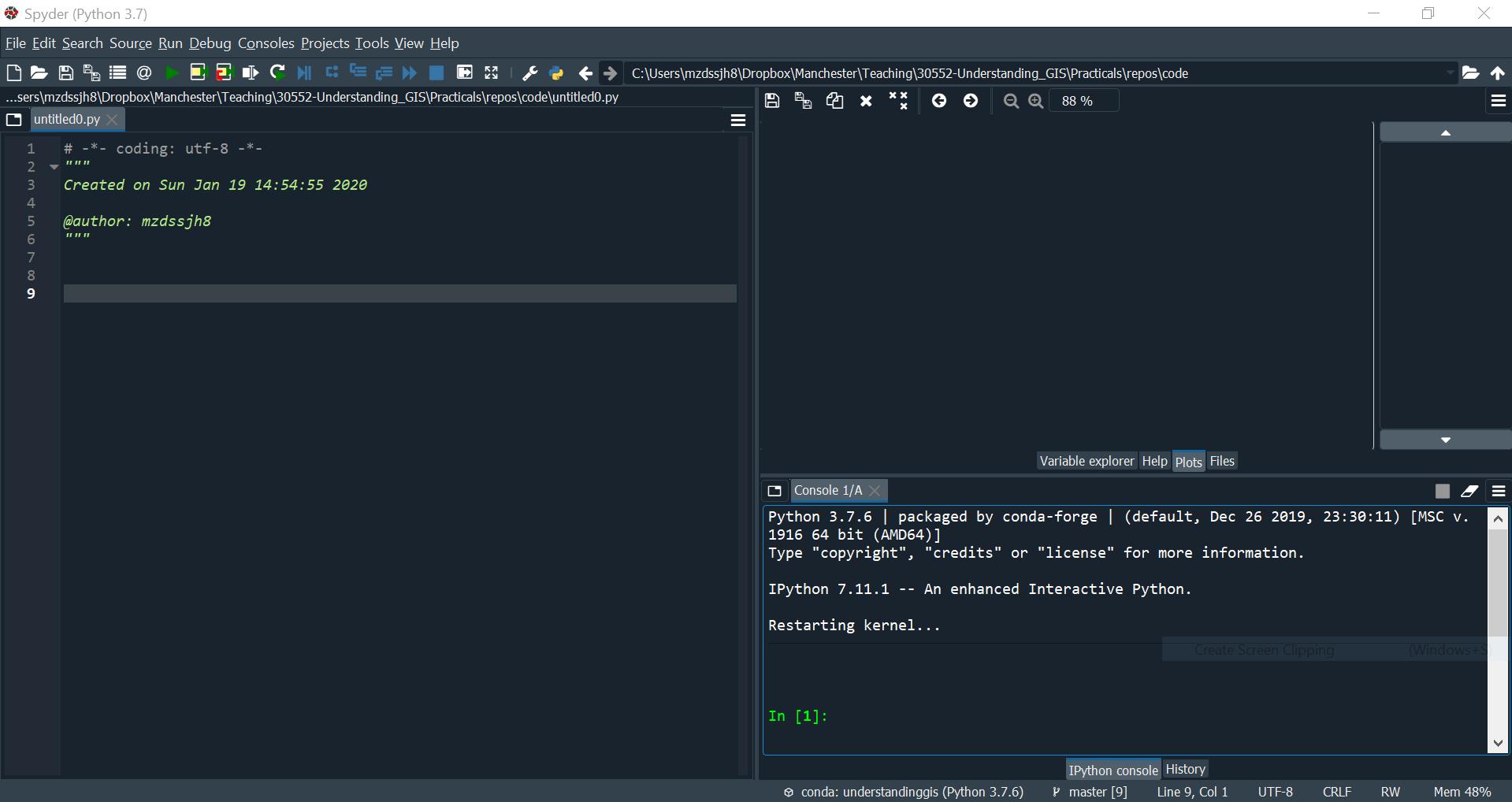
As you can see, the screen is split into three sections: You have code in the panel on the left, the console in the panel on the bottom right, and an extra panel on the top right where we can draw our maps (which we’ll call plots) - you will need to select the plots tab if it is not selected automatically.
Note that on the first use you might get a message in the console pane saying something like Matplotlib is building the font cache, this may take a minute. Give it 5 mins then click the x where it says Console 1/A. All being well, the job will have completes and you will have no problems (which looks roughly like the screenshot above).
If the warning stays there for more than a few minutes, you might have a problem caused by an error made by IT during installation, you can see how to fix it here, or simply put up your hand and one of the staff will come and sort it for you.
Please remember that, as with Anaconda Spyder is not an essential part of Python - in fact, I don’t particularly like it! You could equally write Python in Notepad, Notepad++, Idle, PyCharm, VS Code, Netbeans, or one of many other IDE’s. One advantage of Spyder is that it has lots of useful features for Python developers, such as the run button (to execute your code), the plots pane (so you can see what your maps look like automatically), and so on. Nevertheless, it is important to understand that Python is the language, and Spyder (like Anaconda) is simply one of many tools designed to help you write it! This is important because, for example, if you don’t like Spyder, this doesn’t mean that you don’t like Python - you can just switch to a different editor!
Building a Directory Structure
One of the most common problems that students face in programming classes is losing their work. To try and avoid this, I want you to all to create the same directory structure and use it strictly, that way, you will always know where your work is.
Create a directory called
understandinggisand enter it - this is where you will save all of your work for this course - You should place this inside your P drive if you are using a lab machine, otherwise it will not be accessible from other machines in the future!
I now want you to add 12 folders entitled week1…week12, and 2 called assessment1 and assessment2 each of which will contain a folder called out. However, GIS experts like us are all far too busy and important to spend time making all 25 folders by hand like some sort of caveman - so we will use Python to do it for us!
Copy and Paste the below code snippet into the code panel in Spyder:
from pathlib import Path
# count numbers from 1-12 - one for each week of the course
for n in range(1, 13):
# ignore reading weeks...
if n not in [6, 10]:
# make the file path
path = f"./week{n}/out"
# create the directory for week n
Path(path).mkdir(parents=True, exist_ok=True)
# if the number is <2, add an assessment folder too...
if n < 3:
# make the file path
path = f"./assessment{n}/out"
# create the directory for assessment n
Path(path).mkdir(parents=True, exist_ok=True)
# create the directory for data
Path("./data").mkdir(parents=True, exist_ok=True)
Now click File → Save As or Ctrl+Shift+S and save the file in your
understandinggisdirectory, call itcreate_directories.py. Now press the Run button (or press F5):

The first time you run some code in Spyder, it might open a box called Run Settings, which asks several questions under the headings: Console, General Settings, Working Directory Settings and External System Terminal.
Simply ignore all of these, ensure that the check-box next to Always show this dialog on a first run is un-checked and press Run. The default values are fine for all of these settings, and the check box should prevent it from asking again. If you do see it again, just do the same.
Now, click on the Files tab in the top right-hand pane of Spyder, you should see that all of your lovely directories have appeared saving you valuable minutes of your life that you would otherwise have had to spend mindlessly clicking away at your mouse, as if you were some sort of Victorian street-urchin. (Obviously, you can also see this in Explorer on (Windows or Finder on Mac). Hurrah!
Having a go at some Python
The above is all well and good, but it doesn’t really teach you much. To learn how to write some Python for ourselves, we need to go back a few steps
In Spyder, go to File>New or press Ctrl+N to make a new file in the code panel. Copy and paste the following statement into it:
print("hello world!")
Now press Ctrl+S and save the file in your
understandinggis/week1directory, call itweek1.py. Now press the Run button (or press F5):

Your code should run and the console will respond:

Can you see what happened there? You just ran your first program - you gave the computer a command (to print the phrase hello world) and it did it!
Printing Hello World is the traditional first thing that any programmer does with a new language - and now you are part of this great tradition!
What do you think will happen if you change it to
print(2+2)and run it again? Try it, were you right?
Python Fundamentals
Now we’re up and running, I am going to briefly introduce you to a few simple programming concepts, and then we are going to get stuck in and write a program. First though, a quick reminder of why we are learning this stuff:
Being able to give commands directly to the computer is a big step forward as a GIS expert, as it makes us less reliant upon other people’s software such as QGIS or ArcGIS. There are several reasons that we want to be able to do this:
- Desktop GIS has limited functionality, and you can only do a certain set of operations within it. With programming, we have the freedom to do whatever we want!
- Desktop GIS is often ‘black box’ - we fill in some boxes and press buttons knowing that it will give us an answer in return, but we have no idea what it does to get that answer. This is very un-scientific, and prevents us from fully understanding what we do. With programming, however, we can see exactly what we are doing, and so we can gain a much deeper understanding of GIS.
- If you need to do something many times over, this can rapidly become pretty boring and very time consuming with desktop GIS. With programming, however, you only need to write the code once, and then can run it a thousand times in a matter of seconds, which can save you a lot of time!
It is also worth reflecting on why we have chosen to use Python as our programming language of choice:
- Python is a multi-paradigm programming language. This means it supports lots of types of programming, in contrast with more limited languages, such as R, for example. R is a Functional Programming language, this makes it easy to use for non-experts (it is aimed at mathematicians), but is quite limiting when you want to do something more advanced. In Python, you can use functional programming approaches if you wish, but you can also use other programming paradigms such as Procedural Programming and Object Oriented Programming. We will be using the latter in this course, and is important to be able to work across multiple paradigms if you want to keep building your skills in computing beyond the basics.
- Python is a high level programming language, making it quicker to learn and easier to write than many lower level programming languages, such as Java or C++, because it has a simple syntax and does a lot of things for you in the background (such as determining the type of variables - more on this later). This makes the rapid progress that we need to make in this course much more achievable.
- Python is open source, and is not limited by commercial licenses like other scientific languages, such as MatLab and Mathematica. Once again, this makes it more scientific, more robust, and more reliable. It is also cross platform, you can run Python on pretty much any computer in the world!
- Python has one of the best ecosystems of libraries available of any language. You name it, and there is probably a Python library for it! Most importantly, Python is the most widely used programming language for GIS applications, particularly in industry, and it is also the scripting language of choice for most major desktop GIS packages (ArcGIS, QGIS etc) - meaning that you can write Python inside these programs to give yourself greater control over what they do!
Python therefore represents a bit of a ‘Sweet Spot’ for writing GIS software. So let’s get to it - here are some of the fundamentals of Python programming:
Comments
When programming, it can quickly become hard to remember what each part of your code does, which can cause difficulties further down the line. To get around this, programmers use comments, which are lines of code that get ignored by the Python interpreter, and so serve no purpose other than to make the code more readable.
To add a comment, simply insert the # symbol. Everything after it will be ignored:
# This doesn't do anything...
print("Hello World!") # ...neither does this!
print(2+2)
Try adding some descriptive comments to your program in Spyder and re-running it. Does it still work?
For the purposes of this course, comments are particularly important, as they are used to help me mark your work! Here is a useful rule of thumb for writing good quality code:
A good rough guide for well-presented code is that you should have roughly:
- one-third code
- one-third white space
- one third comments.
This is called the Rule of Thirds - remember it (particularly around assessment time…)!
Variables
One of the most important things to know about in Python (or any other programming language) is the variable. Variables are containers in which you can store values, and then retrieve them later. Python creates variables for you as you need them, so all that you need to do to create one is type its name and then use an = sign to assign a value to it. Here is an example:
# assign values to some variables
value_1 = 2
value_2 = 4
# use those variables to calculate a value for another variable
value_3 = value_1 + value_2
# print out the value of that variable
print(value_3)
Paste the above into
week1.pyin Spyder, save it and run it. What does the above print out? Is it what you expected?
In Python, variable names can’t have any spaces or characters that are not a-z, A-Z, 0-9 or _ in them, and they cannot start with a number. By convention, variables in Python are normally written in snake_case (as opposed to UPPER CASE or lower case), which is where all words are in lower case, and separated by underscores (_). All of these are valid variable names in snake case:
snake_casea_really_long_variable_nameshortimy_variable
Each variable will have a particular type, which specifies what kind of a value it can hold. Whilst you do not have to specify the type yourself (because Python works it out for you), it is important that you understand what the different types are, as not understanding this will lead to errors later on. Fortunately, it’s pretty simple:
| Variable | Explanation | Example |
|---|---|---|
| String | Some text. To signify that the variable is a string, you should enclose it in either single ('...') or double ("...") quote marks. |
my_var = "Bob" |
| Integer | A ‘round’ number with no decimal places. Numbers don’t have quotes around them. | my_var= 10 |
| Float | A number with decimal places. Numbers don’t have quotes around them. | my_var= 10.5 |
| Boolean | True or False |
my_var= True |
Create your own variable add a value to it, and print it out using the
print()function (check the snippet above to see how it is done!)
In a compiled programming language, we would have to specify which type of value a variable will hold at the time it is created. In Python, however (an interpreted programming language), we can let it work that out for us! This is called dynamic typing, and is one of the many features that makes Python so easy to read.
A word about Objects and Collections
We will get to objects and collections in greater detail later on in the course, but for the next bit, it would be good for you to have a general understanding of what an object is. Simply, variables that do not refer to the above 4 types might refer to an object.
In programming, we often create objects to represent things that exist in the world. Objects could be Map, Rock, Lake, Person, Coordinate_Reference_System, absolutely anything that your program needs to understand. Objects might have properties (code that stores information about them) and Functions (code that does something, or works something out). We will learn about these in greater detail later, but for now, here is a quick example:
Imagine that we were making a programmatic woodland. Objects that we created would probably include:
Woodlandto represent the woodland itself. This might have a property callednumber_of_trees, and a function calledget_trees(), which returns a list of all the trees in the woodland.Tree, which make up theWoodland. EachTreemight have properties such asage,height,speciesetc., as well as functions such asgrow(),drop_leaves()andfall_over(), for example.Squirrel, which lives in aTree. They might have properties such asage,species,which_tree_i_live_inandnumber_of_nuts_stashed_away_for_winter, and functions such aseat(),sleep(),stash_nut(),poo()anddie().
By creating these objects, we can quickly and easily build up a well organised model of the woodland. This approach to programming is called Object-Oriented Programming, and we will discuss this in more detail later in the course. For now, it is enough to have a general understanding of what an object is: a bit of code that represents something.
In Part 2 you will use your first object: a GeoDataFrame - this is an object that represents a GIS dataset, and it contains lots of functions to allow us to do things with that dataset, such as extract and filter data from it, add data to it, or draw it onto a map!
A Collection, on the other hand, is simply a list of objects stored together (e.g. you could store all of the Tree objects associated with a particular Woodland object in a collection) - we come to these in more detail next week.
Errors
It is an interesting fact that, however good you are, you will spend more of your time debugging code (identifying problems with it), then you will actually writing code. This is true for all programmers, the better you get, the more complex the problems that you need to solve!
The good thing is that the Python interpreter will do its best to help you fix any code that it cannot run by providing you with a detailed error message.
Consider the following code, which I have saved in a file called error.py and tried to run:
a = 2
c = a + b
print(c)
Clearly, this will not run, because the variable b does not exist. Python thererfore returns this into the console at the bottom of the screen:
.../error.py
Traceback (most recent call last):
File ".../error.py", line 2, in <module>
c = a + b
NameError: name 'b' is not defined
Process finished with exit code 1
Add the the Python snippet above to your code (not the error message!) and run it - do you get the same error?
As you can see, tells us the line number (line 2) where the error was found, the line itself (c = a + b), and a description of the error: NameError: name 'b' is not defined.
These are all helpful bits of information that are here to help you - do not just ignore them and think “it doesn’t work” or “I can’t do it” - this is what programming is - programmers will spend about 20% of their time writing code and 80% of their time fixing it. This doesn’t change as you get better at it - the problems just get more complicated! The good news is that Python is always doing its best to help you to find any problems with your code, so that you can fix them!
Learning to understand and interpret error messages is a vital skill for any programmer. If you have not been able to resolve the problem or you don’t understand the message, you should then Google it (normally by just typing “Python” followed by the error message into Google), e.g.
https://www.google.com/search?q=Python+NameError+name+b+is+not+defined
If you are still unable to resolve it, then this is where you would use the Python Programming Forum on Blackboard (or ask for help if it is during a class).
Stop here, time to go back to the lecture!
Part 2.
Making a Map in Python
Firstly, download this file and extract it (Right click → Extract All on Windows) and click Browse to set the output directory to be your
P:\understandinggis\datadirectory.
On a Mac, just drag the zip file into the
understandinggis/datadirectory and double click on it. Note: this may create an additionaldatasub-directory (understandinggis/data/data) so files can either be dragged to the top-leveldatadirectory or extracted using the unzip command via the terminal.
The first thing that we will do is to load the library that we use to read and write data: geopandas. This is a library that contains the code for a GeoDataFrame - this is a computational representation of GIS data, and is one of the fundamental elements that we will use in the software that we write for this course.
Delete all of the previous code in
week1.pyand paste in the following snippet then Run the code:
from geopandas import read_file
# load the countries data into a GeoDataFrame
world = read_file("../data/natural-earth/ne_50m_admin_0_countries.shp")
# test the contents
print(world.head())
world.head() is a simple convenience function that prints out the first five lines of the dataset, just to that we can see what is in there. If all went to plan, you should have an output that looks something like the below. Note the ellipsis (...), this means that there is missing data that can’t fit on the screen. It might be that you have a few more or a few less columns (the below includes the index number of each row and two columns: featurecla and geometry) - this is fine as long as it looks roughly the same - all that we are trying to achieve here is to check that there is some data there:
featurecla ... geometry
0 Admin-0 country ... POLYGON ((31.28789 -22.40205, 31.19727 -22.344...
1 Admin-0 country ... POLYGON ((30.39609 -15.64307, 30.25068 -15.643...
2 Admin-0 country ... MULTIPOLYGON (((53.08564 16.64839, 52.58145 16...
3 Admin-0 country ... MULTIPOLYGON (((104.06396 10.39082, 104.08301 ...
4 Admin-0 country ... MULTIPOLYGON (((-60.82119 9.13838, -60.94141 9...
A quick note on File Paths…
*Note: **The ../ at the start of the file path means *‘go up one directory’ - this is necessary because your data folder is not inside the same directory as your python file (week1), but is in the folder that contains it (understandinggis)*:
- understandinggis/
- data/
- week1/
- week1.py
- out/
- week2/
- etc...
For reference:
/means go to the ‘root’ directory - you will almost never want to do this./means use the current directory../means go up one directory../../means go up two directories../../../means go up three directories- and so on…
Windows users will be used to seeing back slashes (\) in file paths - this is one of the many quirks of the Windows operating system, and one of the reasons that it is not widely used by programmers. When coding, you should always use forward slashes (/).
…Back to the Practical…
So what did we just do?
- We imported
read_file()function from thegeopandaslibrary, which is used to load GIS data into a GeoDataFrame.importstatements like this make functionality from libraries available to our code - if you forget toimportthe function first, then your code will have no idea what to do when you try to use it, and you will get an error. - We used the
read_file()function (that we imported from thegeopandaslibrary) to read in thene_50m_admin_0_countriesdataset to a GeoDataFrame object, which we store in a new variable calledworld. - We then call the
.head()function of the object stored in theworldvariable. This is a convenience function that returns the first 5 rows (the “head”) of the dataset, which is normally used just to check it. In our case, we are passing the result to theprint()function, which is built in to Python, and so does not need to be imported. This makes it print out the result of.head()into the console.
Stop here and make sure that you understand those three lines of code
This allows you to see the structure of a geodataframe object - effectively, it is just a table of values, where each row refers to a spatial object. Each column refers to an attribute of the object in that row (e.g. its name, country code, population etc.) and the final column is the geometry itself (in this case Polygons and Multipolygons - which is what we would expect for a country). This is analogous to the Attribute Table that you will have seen in software such as QGIS or ArcGIS.
Because head() worked, we know that we have successfully loaded our dataset into a GeoDataFrame!! We can now plot it onto a map using pyplot with just a few more lines of code:
Firstly, add this
importstatement immediately after the existinggeopandasimportstatement:
from matplotlib.pyplot import subplots, savefig
This will import two more functions into our code (subplots and savefig ) from the matplotlib.pyplot library. This is the library that deals with drawing maps for us.
Now, add the following snippet to the end of your code and run it:
# create map axis object
my_fig, my_ax = subplots(1, 1, figsize=(16, 10))
# plot the countries onto ax
world.plot(ax = my_ax)
# save the result
savefig('./out/1.png')
print("done!")
This section uses the subplots() function that we imported from the matplotlib.pyplot library in order to create a figure (the ‘canvas’ onto which the map is drawn) and an axis (the map itself), which we will store in the variables my_fig and my_ax respectively.
The terminology relates to the fact that pyplot is used for all kinds of scientific drawing, not just maps. In essence, the figure, is the actual ‘picture’ that you end up with, which can be made up of one or more axes - as you can see in the below illustration from Earth lab (I know that this is a little confusing, but you will get the hang of it in no time!):
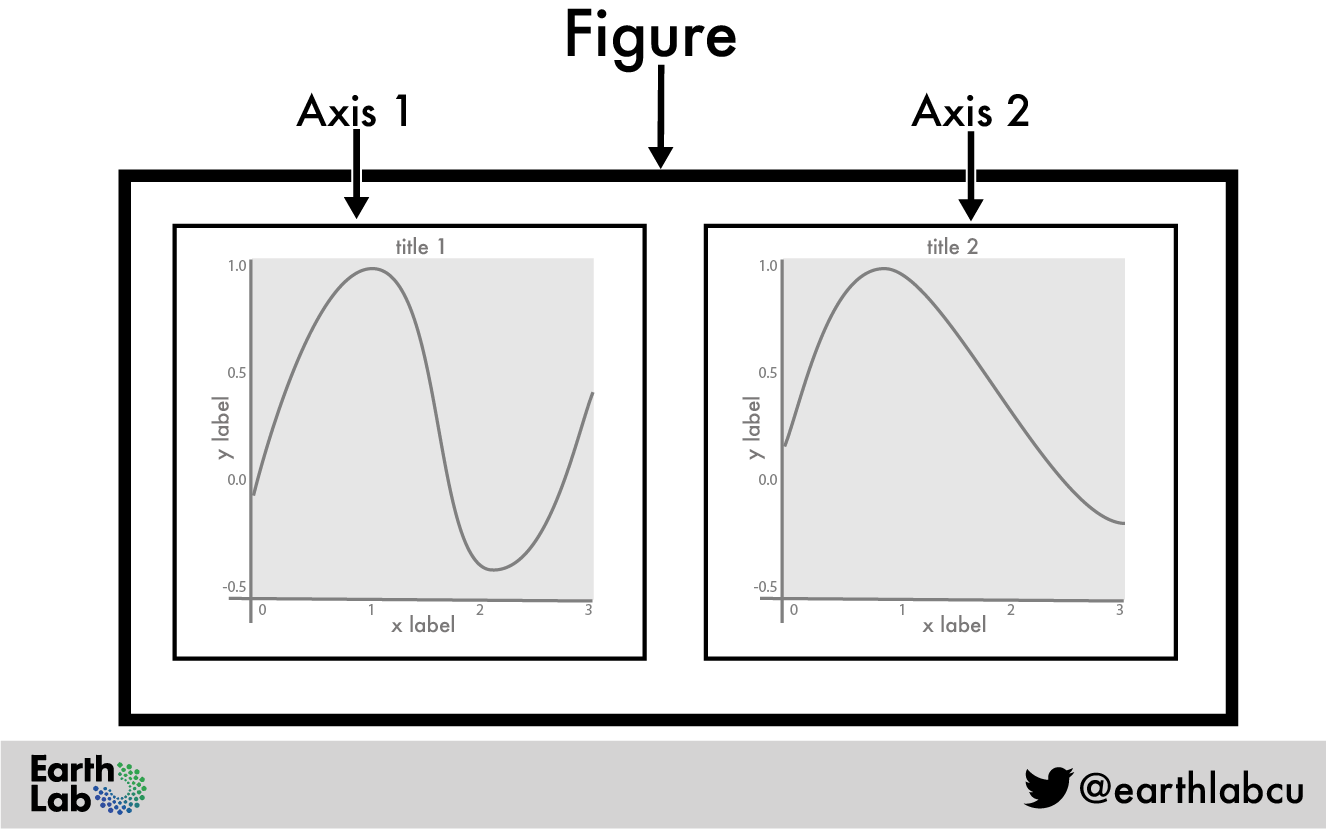
Now we have an axis object (my_ax), we draw the data to it with world.plot(ax = my_ax). Here we are using the .plot() function of the GeoDataFrame object in our world variable to draw the map. Crucially, by setting the ax argument to our my_ax variable - we make it draw onto the axis my_ax, which is contained within our figure (my_fig).
Finally, we save the figure with the savefig() function that we imported from matplotlib.pyplot. If all went to plan, you should create a new file in your week1/out directory called 1.png that looks like this:
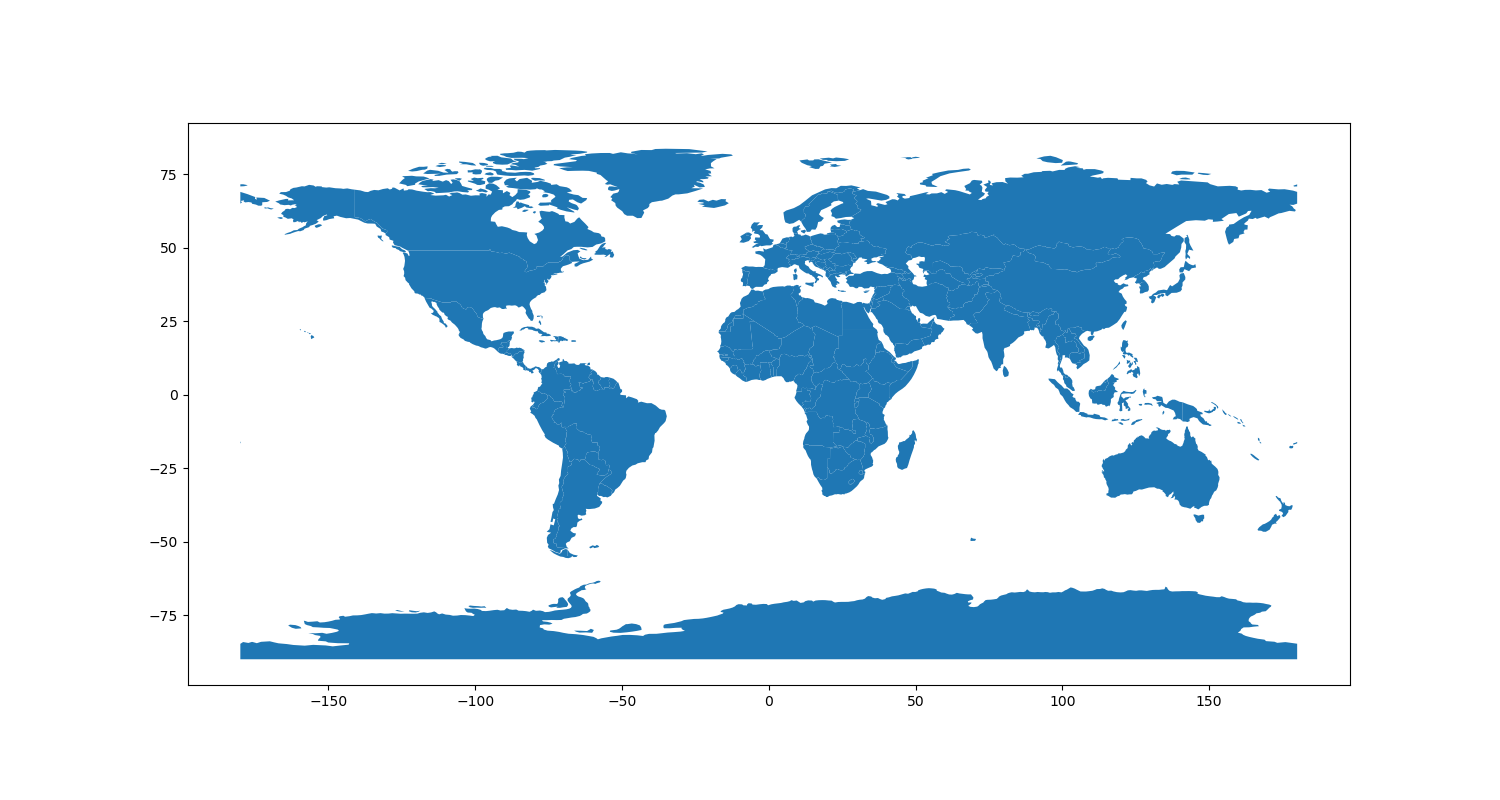
You can view this in Spyder by selecting the Plots tab in the in upper-right panel, or simply by looking at it in Explorer (Windows) or Finder (Mac).
Have a careful read over that section again - does it make sense? If not, ask!
Removing the axes
It is a bit confusing, that pyplot uses the term axis both for the individual map on the figure, as well as for the x and y axis on the sides of the map (the numbers across the left and bottom). Given that these numbers are pretty useless in the context of a global map, we are going to turn them off, which requires us to use the .axis() function of our axis object (that is stored in the ax variable):
I told you it was confusing…
Add the following line to your code - it needs to be after the variable
my_axis created (otherwise the Python interpreter won’t know whatmy_axis) but before thesavefig()function is called (otherwise it will be too late as the image has already been saved to disk!)
# turn off the visible axes on the map
my_ax.axis('off')
Run your code again, if it went to plan, you should have something like this:
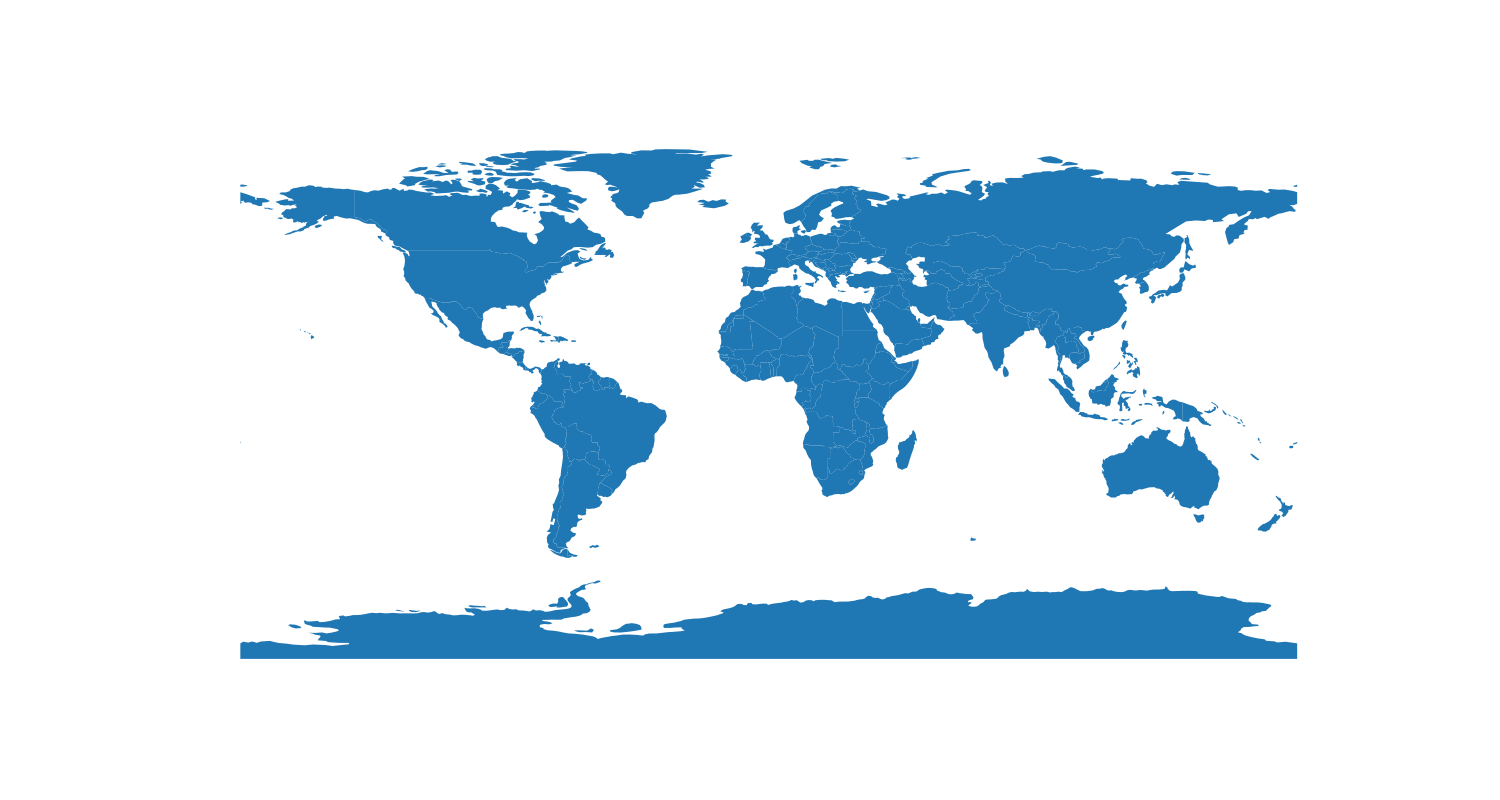
Much better…!
Adding some more data
Now we have a basic map, let’s add some more data to it:
Add the following
read_file()statements immediately after the other one:
graticule = read_file("../data/natural-earth/ne_110m_graticules_15.shp")
bbox = read_file("../data/natural-earth/ne_110m_wgs84_bounding_box.shp")
This load datasets containing a graticule (grid) and a background (representing the sea) into GeoDataFrame objects, enabling us to:
Replace the
world.plot()statement with the the following threeplot()statements and run the code:
# add bounding box and graticule layers
bbox.plot(
ax = my_ax,
color = 'lightgray',
linewidth = 0,
)
# plot the countries
world.plot(
ax = my_ax,
color = 'black',
linewidth = 0.5,
)
# plot the graticule
graticule.plot(
ax = my_ax,
color = 'white',
linewidth = 0.5,
)
If all went to plan, you should now have something like this:
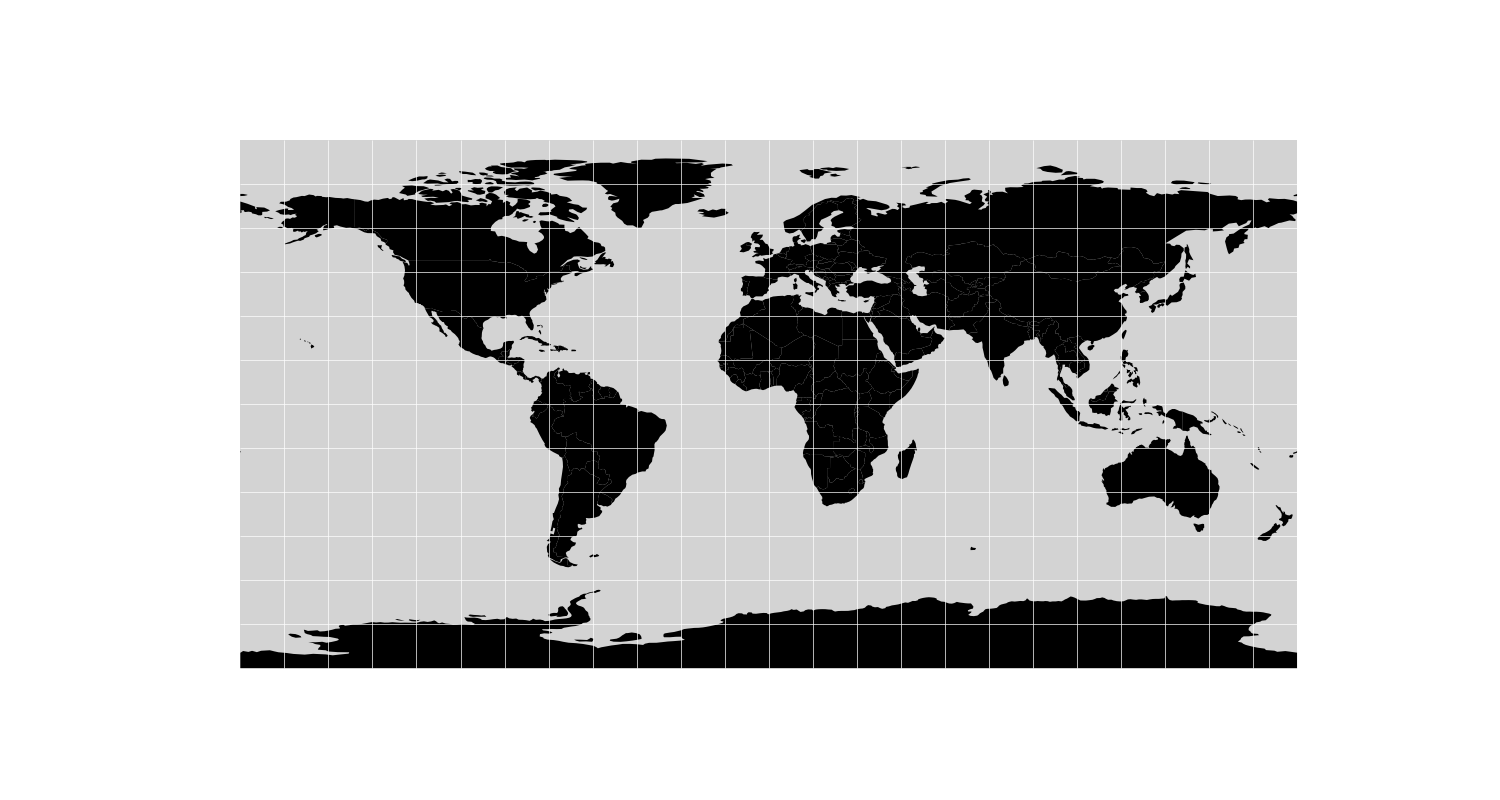
Much better, right?
Now change the colours around until you are sure that you have got the hang of how it works
Styling using data
Now we have a map, we can use it to show us something about our dataset.
Note that not all of the columns are shown in the sample that you get back from the print(world.head()) statement, as the data would be too wide to fit in the console window.
To see a complete list, add the below line to your file immediately after the world variable is populated, and then re-run your code:
print(world.columns)
If all has gone to plan, you should have something like this in your console:
Index(['featurecla', 'scalerank', 'LABELRANK', 'SOVEREIGNT', 'SOV_A3',
'ADM0_DIF', 'LEVEL', 'TYPE', 'ADMIN', 'ADM0_A3', 'GEOU_DIF', 'GEOUNIT',
'GU_A3', 'SU_DIF', 'SUBUNIT', 'SU_A3', 'BRK_DIFF', 'NAME', 'NAME_LONG',
'BRK_A3', 'BRK_NAME', 'BRK_GROUP', 'ABBREV', 'POSTAL', 'FORMAL_EN',
'FORMAL_FR', 'NAME_CIAWF', 'NOTE_ADM0', 'NOTE_BRK', 'NAME_SORT',
'NAME_ALT', 'MAPCOLOR7', 'MAPCOLOR8', 'MAPCOLOR9', 'MAPCOLOR13',
'POP_EST', 'POP_RANK', 'GDP_MD_EST', 'POP_YEAR', 'LASTCENSUS',
'GDP_YEAR', 'ECONOMY', 'INCOME_GRP', 'WIKIPEDIA', 'FIPS_10_', 'ISO_A2',
'ISO_A3', 'ISO_A3_EH', 'ISO_N3', 'UN_A3', 'WB_A2', 'WB_A3', 'WOE_ID',
'WOE_ID_EH', 'WOE_NOTE', 'ADM0_A3_IS', 'ADM0_A3_US', 'ADM0_A3_UN',
'ADM0_A3_WB', 'CONTINENT', 'REGION_UN', 'SUBREGION', 'REGION_WB',
'NAME_LEN', 'LONG_LEN', 'ABBREV_LEN', 'TINY', 'HOMEPART', 'MIN_ZOOM',
'MIN_LABEL', 'MAX_LABEL', 'NE_ID', 'WIKIDATAID', 'NAME_AR', 'NAME_BN',
'NAME_DE', 'NAME_EN', 'NAME_ES', 'NAME_FR', 'NAME_EL', 'NAME_HI',
'NAME_HU', 'NAME_ID', 'NAME_IT', 'NAME_JA', 'NAME_KO', 'NAME_NL',
'NAME_PL', 'NAME_PT', 'NAME_RU', 'NAME_SV', 'NAME_TR', 'NAME_VI',
'NAME_ZH', 'geometry'],
dtype='object')
There is quite a bit of data there, here is an interesting selection:
| Column | Description |
|---|---|
POP_EST |
The estimated populaton of the country |
CONTINENT |
The continent that the country includes the country |
NAME |
The name of the country |
ISO_A3 |
A unique 3 letter code for each country (e.g. GBR for the United Kingdom) |
GDP_MD_EST |
The estimated Gross Domestic Product (GDP) for the country |
geometry |
The geometry (shape) of the countries |
For example, let’s colour each country according to the estimated population:
Replace the
world.plot()statement with the below snippet and run the code
# plot the countries
world.plot(
ax = my_ax,
column = 'POP_EST',
linewidth = 0.5,
edgecolor = 'gray',
cmap = 'OrRd',
scheme = 'quantiles',
)
You should now have something like this, where darker colours represent greater population:
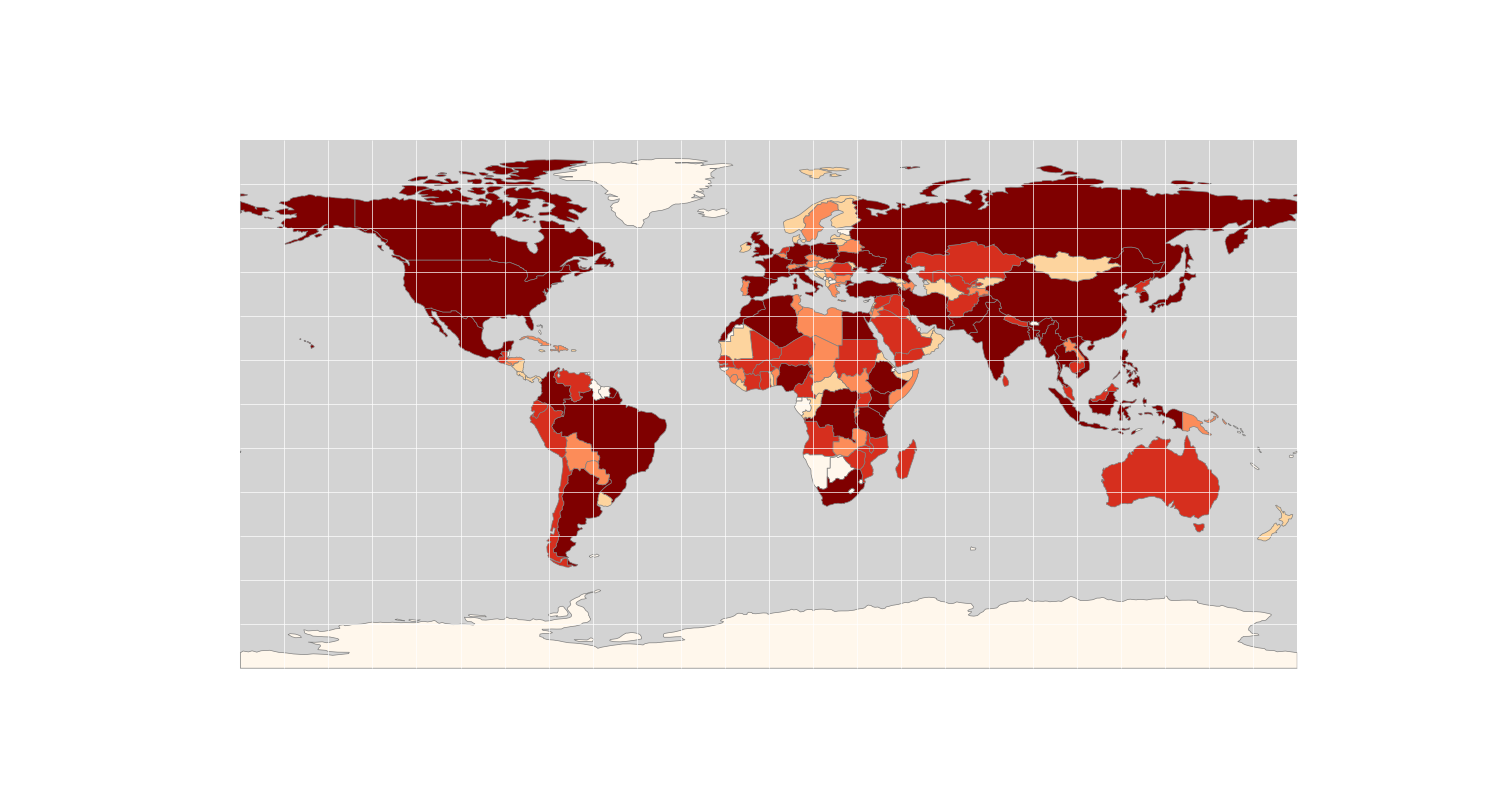
Let’s just have another quick look at that snippet - you should be able to work out from the names what each argument in the plot() function is doing there, but a few key parts are:
column = 'POP_EST' - this is the name of the data column with which we want to colour the map
cmap = 'OrRd' - this is the name of the colour ramp that we want to use top colour the map. There are many options available (below are just the sequential patterns):

scheme = 'quantiles' - this is the name of the classification scheme (how the data values are classified to the various colours). Quantiles is an ‘equal count’ classifier, where the data are divided into 5 classes, each with the same number of data points. There are lots of options here too, listed on the mapclassify website, though not much information is given, so you will need to look them up and/or use trial and error to explore them!
Setting the CRS and Calculating New Columns
On the face of it, this looks great, until you realise that in most cases, the colour really just relates to the size of the country (with the odd exception). It is far more interesting to look at population density, which is the population divided by the area of each country. In order to achieve this, we simply need to create a new column in our dataset that is equal to the number of people per km2.
However, before we do that, we need to set the Coordinate Reference System (CRS) of the map. The map is currently being drawn without any defined CRS, resulting in what we call an equirectangular or plate careé projection. However, as we heard in the lecture, if we want to do a calculation based on area, we need an Equal Area projection. The big question is… which one…?
Understanding CRS’ in detail is important for a GIS expert, but this is not the purpose of this module. For this reason, we will often turn to a useful online tool called the Projection Wizard. The tool is described in detail in Šavrič et al (2017) and is based on a range of studies into the selection of map projections, including: Jenny et al (2017)., Šavrič et al., 2015. and Snyder, 1987.
Basically, all you have to do is tell the wizard which region you want to map (either by typing the coordinates in or dragging the box on the map), and what kind of projection you want (equal area, conformal, equidistant, compromise) - it will then make one or more suggestions for which you should use:
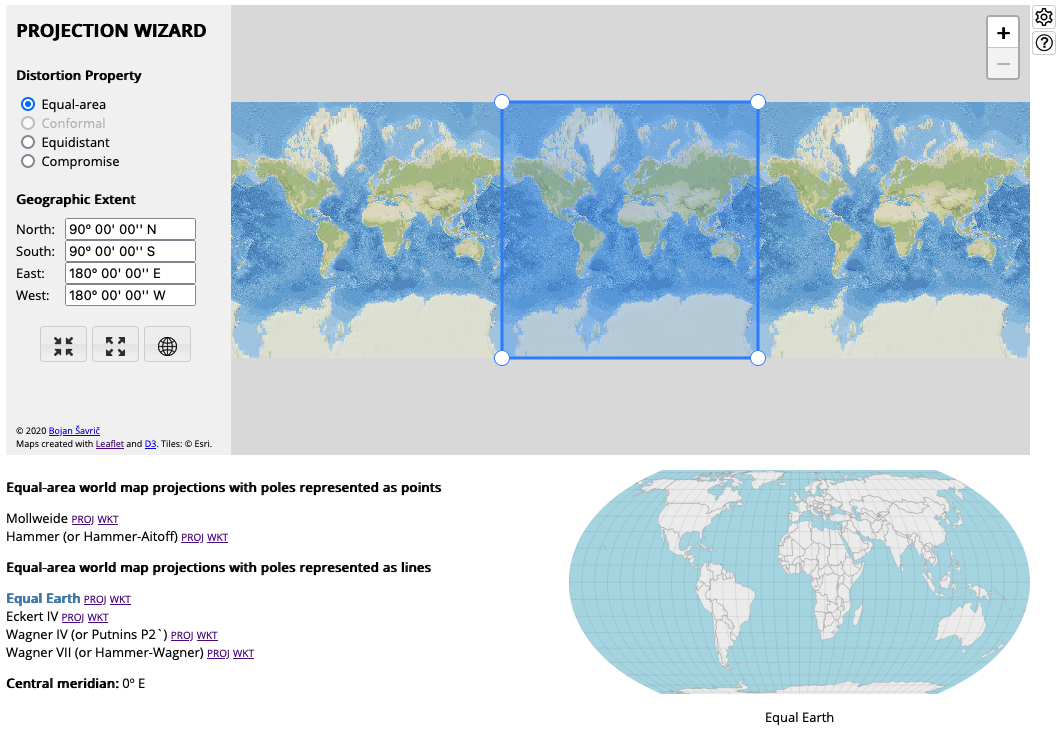
Go to the Projection Wizard, it should already be set up for an Equal Area World Map.
Have a play with it to get a feel for how it works, then set it back to Equal Area and a world map centered on the Greenwich Prime Meridian
Click on each of the six suggestions to compare them and select one.
There are two ways to represent a CRS to pass to software, and both are examples of strings:
- Proj string: this is the original format used by the Proj software library, which is used to handle CRS’ for almost all geographical software. However, due to changes in the Proj library in recent years, this format is (in some cases) a little less precise. The trade-off is that it is easier to read, write and understand.
- WKT string: this means Well Known Text and is a newer, more flexible and (in some cases) more precise representation. The downside is that they are very long and difficult to understand.
Have a look at both the Proj and WKT strings for your chosen CRS to compare them by clicking on the
ProjandWKTlinks next to your chosen CRS.
This should bring up a box like this (my selection is the Equal Earth Projection) - you can see the difference in complexity!
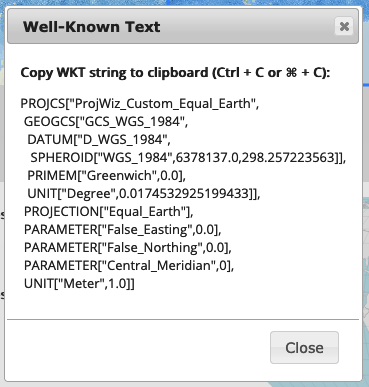
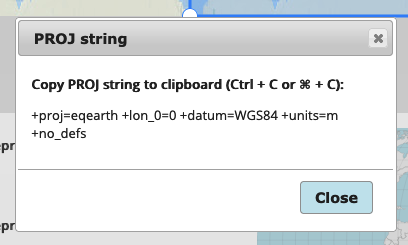
Before we go any further - note that the extent of your CRS has to align with the extent of your dataset, otherwise some of your data will ‘fall off the end of the end of the world’, which causes unpredictable errors in drawing the map. This is sometimes referred to as the antimeridian wrapping problem. Our dataset is centered on the Greenwich Prime Meridian (0 degrees East/West) so, because we are dealing with a global dataset, we need to make sure that our CRS is as well. In a Proj string, this is shown by the parameter +lon_0=0. In a WKT string, this is shown by the parameter PARAMETER["Central_Meridian",0]. In either case, you can simply return the Wizard to this position by pressing the Select Entire World button:

Check that your CRS matches the dataset using the above explanation to make sure thart your CRS is centered on 0 degrees East/West.
In time, it is likely that WKT representation is the only one that is used. For now, we can use either, and we will use both during the course. For simplicity today we will use the Proj string.
Copy the Proj string for your chosen CRS, and store the result as a string in a variable called
ea_proj-remember to use speech marks (" ") to define the string!!
Add the following snippet to transform your three datasets into the Equal Area projection.
# reproject all three layers to equal earth
world = world.to_crs(ea_proj)
graticule = graticule.to_crs(ea_proj)
bbox = bbox.to_crs(ea_proj)
Note: These statements will need to be after the read_file() statements (otherwise the Python Interpreter won’t know what the world, graticule and bbox variables are), and also after the definition of the Proj string (otherwise it won’t know what the ea_proj variable is). However, it must be before you try to plot any of the datasets using a .plot() function (as otherwise you will apply the projection after it has already drawn the map, meaning it will have no effect!).
Now, we can use GeoPandas to create a new column in our GeoDataFrame called pop_density, which we can create simply by specifying the name: world['pop_density']. We then use the values from the existing POP_EST column (world['POP_EST']) and the area property of the GeoDataFrame object (world.area). We divide the area by 1000000 to convert the value from people per m2 to people per km2.
Add the following snippet after the projection statements then add a
print(world.columns)statement immediately afterwards - has your new column appeared?
world['pop_density'] = world['POP_EST'] / (world.area / 1000000)
Note how geopandas allows you to simply use data columns as if they are numbers - this makes our life very easy compared to having to work our way through all of the values in each column manually!
Update the
columnargument of theworld.plot()function topop_densityand Run the code.
If all went to plan, you should have something like this (remember that it will only look exactly the same if you picked the same CRS as me - Equal Earth - it doesn’t matter which you pick as long as the oputput matches the demo on the Projection Wizard):
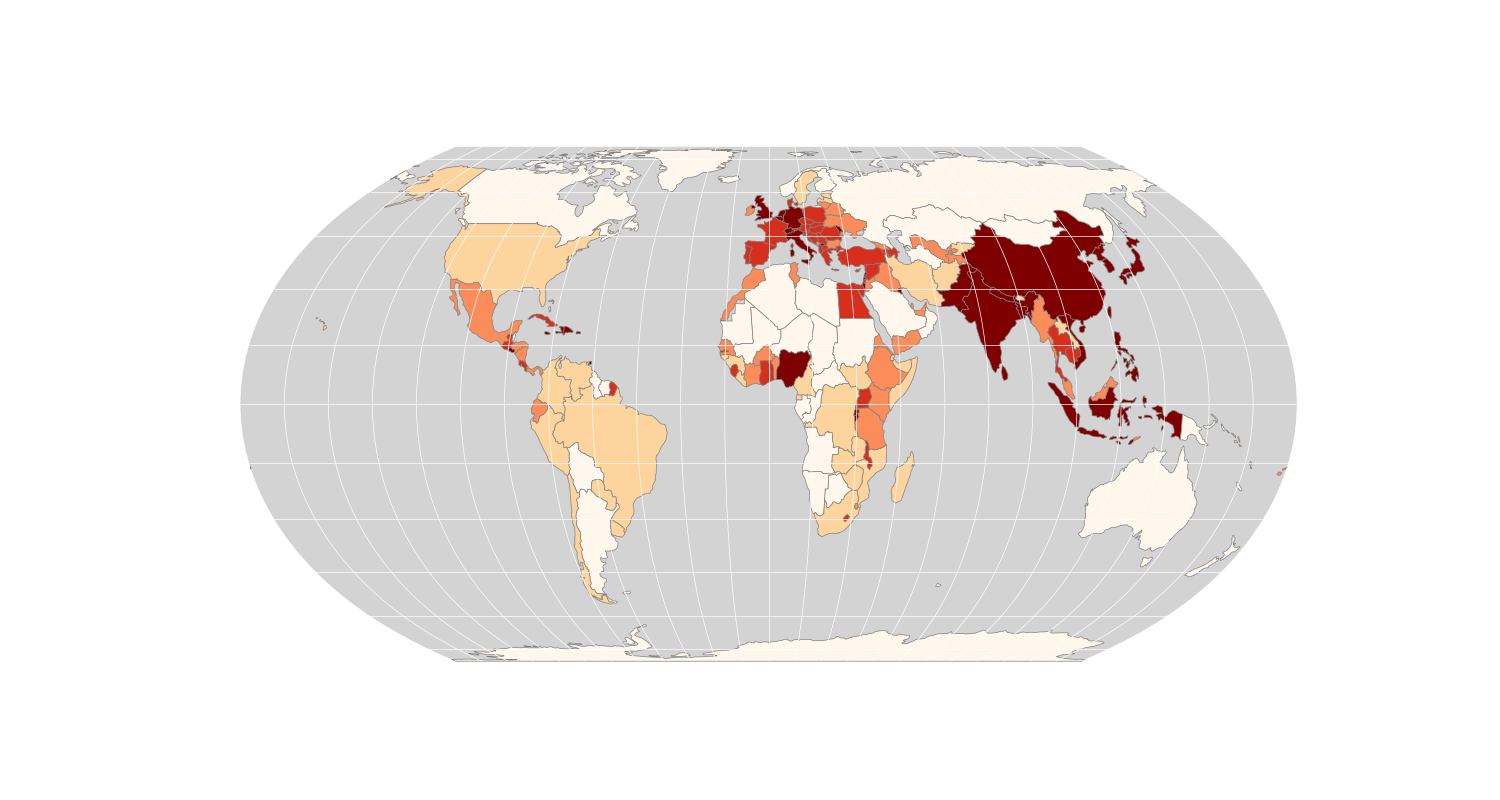
Now our map uses the Equal Area Projection, and displays population density, which is a little more meaningful than population alone. We just need a few final tweaks to finish off our map.
Add the following snippet to your code
Replace
<INSERT CRS NAME HERE>with the name of your chosen CRS
my_ax.set(title="Population Density: <INSERT PROJECTION NAME HERE> Coordinate Reference System")
Note: This statement uses the my_ax variable, so it must be placed after this variable has been created, but before the imaged is rendered (as otherwise it will be too late to change it!):
Add the following extra arguments to
world.plot()in order to add a legend to the map:
legend = 'True',
legend_kwds = {
'loc': 'lower left',
'title': 'Population Density'
}
Run the code
If all has gone to plan, you should have something like the below:
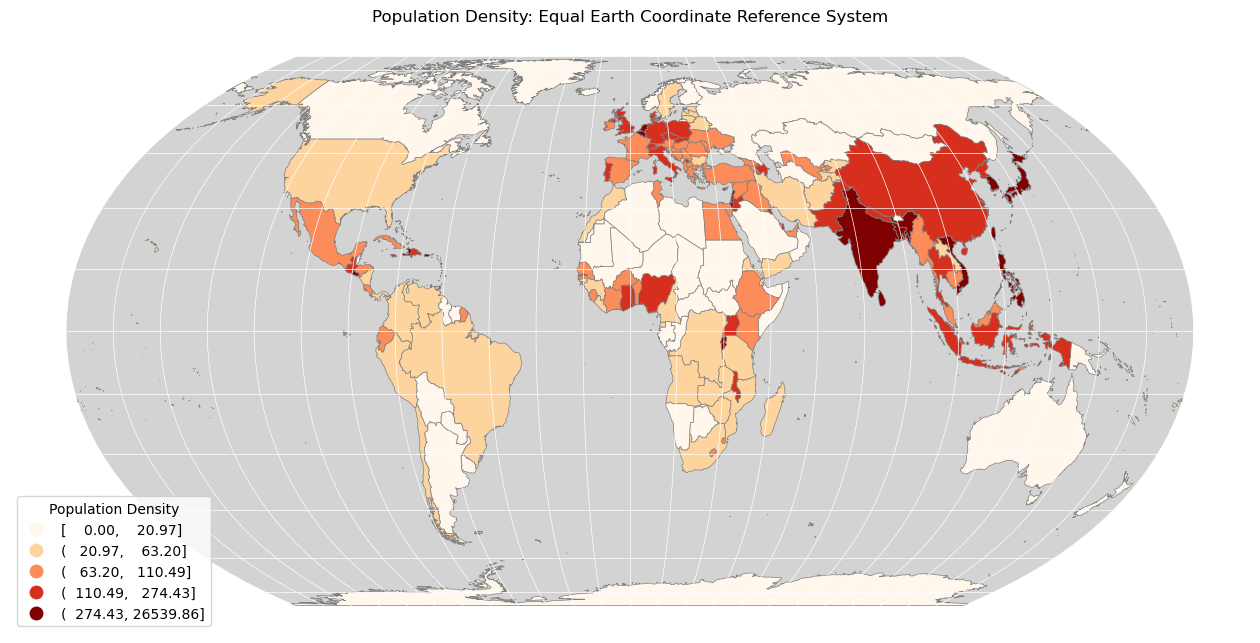
If so, then CONGRATULATIONS!! You have made your first map using GIS!!
Conclusion
Whilst it initially seems like a lot - I hope that this is starting to make sense. It may seem like overkill to write a program to create a simple map such as this, but it means that you have a tremendous amount of control over the maps that you produce as your outputs become increasingly complex (much of what we do in this course isn’t even possible in a desktop GIS!).
We’ve covered a lot of ground today, so please don’t worry if you don’t feel that you understand it all fully, I promise that you will soon! The thing to focus upon is that you have made your first map using nothing but Python, and that’s pretty good going for week one!
See you next week!
A little bit more…?
Each week I will give you a bit of an ‘extra’ challenge that you can address during the week to polish your skill and reinforce your understanding. Here is the one for this week:
Produce a map for GDP Per Capita - an estimate of GDP is given in the column
GDP_MD_EST
Per Capita means per person, so to work this out all you need is the GDP and the population, both of which are already in the dataset!
If you get it right - it should look something like this (comparing the two maps tells us a lot about patterns in the distribution of wealth and people across the world…):
